How to properly propagate currants in the spring by cuttings so that they take root
Cutting currants in the spring is one of the best ways to obtain the required number of bushes. You don’t have to spend money on purchasing planting material. It is enough to choose a healthy mother bush with excellent varietal qualities and cut the cuttings. We will tell you in the article how to carry out cuttings and care for currants after planting.
Features of spring propagation of currants by cuttings

Currants are propagated by seed and vegetative methods. The first is used by experienced gardeners to breed new varieties, the second involves propagation by layering, dividing the bush and cuttings. Blackcurrant varieties take root and develop especially easily.
Cuttings are the most labor-intensive but popular method of propagation.
Its advantages:
- high performance;
- the ability to grow a certain number of seedlings;
- regular renewal of berry plantings;
- rejuvenation of old bushes;
- lack of financial investments;
- preservation of varietal qualities;
- high productivity;
- preservation of taste.
Disadvantages of this method:
- the survival rate of cuttings is slightly lower compared to propagation by dividing the bush and layering;
- the method is suitable for regions with warm and temperate climates, since it provides for autumn planting of cuttings.
Harvesting cuttings
The method of preparing cuttings depends on their type. Gardeners use woody, green and apical ones.
Lignified
Propagation of currants by woody cuttings is considered one of the most effective and reliable methods. From a one-year-old branch of the mother bush, 3-4 strong cuttings are obtained. For propagation, productive varieties without signs of damage by fungi and insects are selected.
Harvesting is carried out in spring or autumn, combined with preventative pruning of bushes. The thickness of the branch should be 6-8 mm, the buds should be healthy and strong. Pruning is performed with sharp pruning shears, having previously disinfected it with medical alcohol 90-96% or a strong solution of potassium permanganate. The upper cut is made straight, at a distance of 1 cm from the kidney. The lower cut should be oblique, under the lower bud. The green top is removed, the branch is cut into cuttings 20-25 cm long. To prevent moisture loss, all leaves are torn off.
Greens
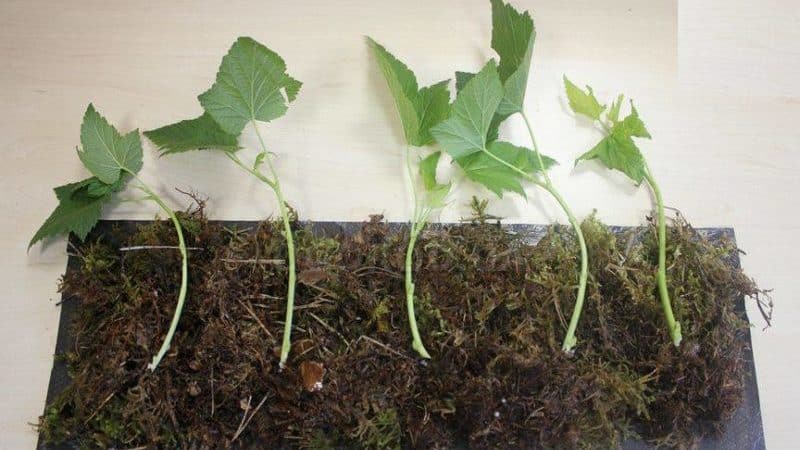
Green cuttings are taken from a mother plant with excellent varietal qualities, without signs of damage by fungi and insects. With further development, any shortcomings are passed on to next generations.
Cutting is done with disinfected pruning shears. To do this, select an annual branch 4-5 mm thick and cut off a flexible, green, non-fruiting shoot. Next, the branch is cut into cuttings 20 cm long, leaving 2-3 leaves and axillary buds. The unripe top is removed.
Experts recommend choosing the middle sections of the branch for propagation, since the lower part rarely takes root, and the tops do not tolerate winter well, despite the high survival rate.
The lower cut of the cutting is made oblique, 1 cm below the axillary bud, the upper cut is made straight, 1 cm above the bud. All leaves on the cuttings are torn off.
Apical
If there is a shortage of planting material, it is recommended to cut cuttings from the apical part of the branch. However, it is worth remembering the low survival rate of apical cuttings compared to green and lignified ones. Apical shoots are highly demanding regarding the type of soil, growing conditions and humidity level.
Harvesting is carried out in late spring - early summer. One-year flexible shoots are suitable for cutting. The procedure is carried out in the morning using disinfected pruning shears. The length of the cuttings should be 10-15 cm. The lower oblique cut is made under the nodal bud. The wood in this area is denser. The apical cuttings are kept in a humid environment until planting.
Methods for rooting cuttings
Gardeners use 2 methods for rooting currant cuttings at home - in water and soil.
In water
For rooting cuttings in water, enamel, glass or plastic containers with a volume of 250-500 ml are suitable. The main rule: the buds must remain above the surface of the water.
How to grow currants from cuttings in a jar of water:
- Distilled water is poured into the container, the cuttings are immersed in it and placed on the windowsill on the northwest or north side. There is no need to change the water, as this slows down the growth of roots; it is enough to periodically add fresh water.
- The cuttings are kept in water for 8-10 days until roots appear. At this moment they are fed with nitroammophoska (5 g per 1 l). As soon as the roots reach 10 cm, the cuttings are planted in paper cups filled with soil (3 parts peat, 1 part sand, 1 part humus). For one glass - one stalk.
- A depression of up to 5 cm is made in the soil, 5 granules of nitroammophoska are added and the cutting is planted. During the first 3 days, provide moderate watering, ensuring that the soil remains moist. Then water 2-3 times a week. The container is kept on a sunny windowsill.
- After a month, the cups are taken out to the balcony for hardening. Start with 15 minutes and increase the time spent in the fresh air to 24 hours. After 1.5-2 weeks, the cuttings are planted in open ground.
In the ground
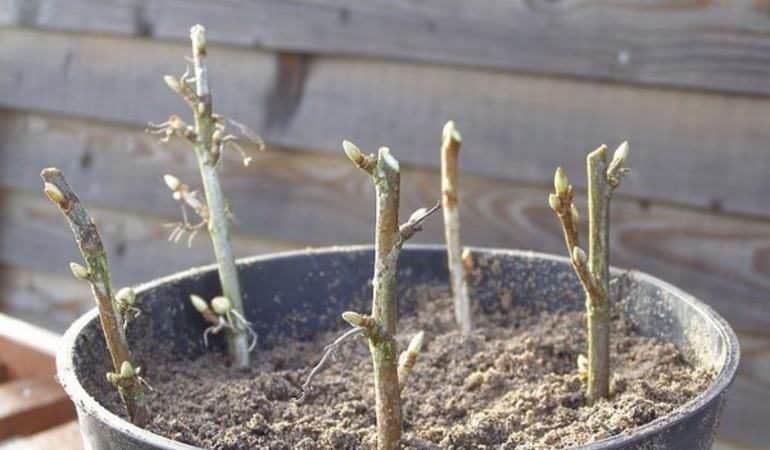
In the northern regions, currant cuttings are rooted in the soil and grown in containers until spring:
- The soil for rooting currant cuttings is prepared from a 1:1 mixture of sand and black soil. Plastic bottles or pots are used as containers.
- Several holes are made at the bottom of the container to drain excess water. Lay a layer of expanded clay or crushed eggshells. Moist soil is poured on top.
- The bottom of the cuttings is dipped in Kornevin powder and buried 2-3 cm into the soil mixture. Leave 2 buds on top.
- The cuttings are watered daily, monitoring the soil moisture. The roots appear 2.5-3 weeks after rooting, and leaves with inflorescences grow from the upper buds.
In the southern regions, currant cuttings are rooted directly in the open ground in the fall. The soil is fertilized with humus or compost. Planting material is soaked in a growth stimulator for 12 hours. Next, the cuttings are dug into the ground at an angle of 45°, leaving 2-3 buds on the surface. The distance between cuttings is 20 cm.
The soil is watered abundantly, mulched with peat or compost and covered with black agrofibre to retain moisture and prevent the growth of weeds. Holes are made in the covering material by cutting the fabric crosswise with scissors.
Reference. To obtain productive currant bushes from apical cuttings, they are rooted in sunny areas. This method is considered the most labor-intensive, and therefore is not particularly popular.
When to transplant cuttings into open ground
Planting dates depend on the growing region.In areas with a harsh climate, cuttings are harvested in the fall and then planted in the spring. In the south and in the regions of the middle zone, cuttings prepared in the spring are planted in September - October so that they have time to take root before the onset of cold weather.
General rules for planting currant cuttings
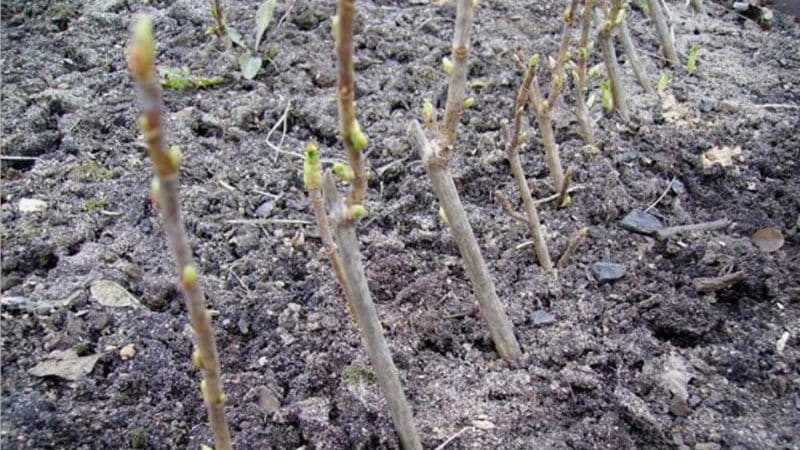
Currants prefer sunny or slightly shaded areas. In the shade, the berries grow small and sour. The soil should be moist with a neutral or slightly acidic pH (6.5-7 units). Soil type - black soil or loam.
The planting area is dug up with cuttings and weeds with roots are removed. The soil surface is leveled with a rake, humus or compost (10 liters per 1 m²), superphosphate (40-50 g per 1 m²) are added. In the prepared area, holes are formed with a depth of 20-25 cm and a diameter of 30-40 cm. The row spacing is 1.5-2 m. The distance between holes is 1-1.5 m.
Fill the hole 1/3 with fertilized soil and place the rooted cuttings at an angle of 45°. The holes are filled 2/3 with earth, it is carefully compacted and 4-5 liters of warm water are poured. Next, the holes are completely covered with soil and 2-2.5 liters of water are poured into each hole. If the gardener has set himself the goal of getting a bush with a large number of shoots, the root collar needs to be deepened by 5-8 cm.
After planting, the tree trunk circle is mulched with peat, compost, pine needles, dry leaves, straw or hay to protect it from the cold. In spring, the mulch is completely removed so that the roots do not dry out.
Features of planting lignified and green cuttings
Before planting, lignified cuttings are soaked in warm water for 15 minutes, then planted in prepared soil at an angle of 45°. 2-3 buds are left above the soil surface.
Green cuttings are soaked in growth and root formation stimulants for 12 hours (Epin, Ribav-Extra, Zircon, Kornevin). Planting material is buried 2 cm into the soil at an angle of 45°.
Caring for currants after planting
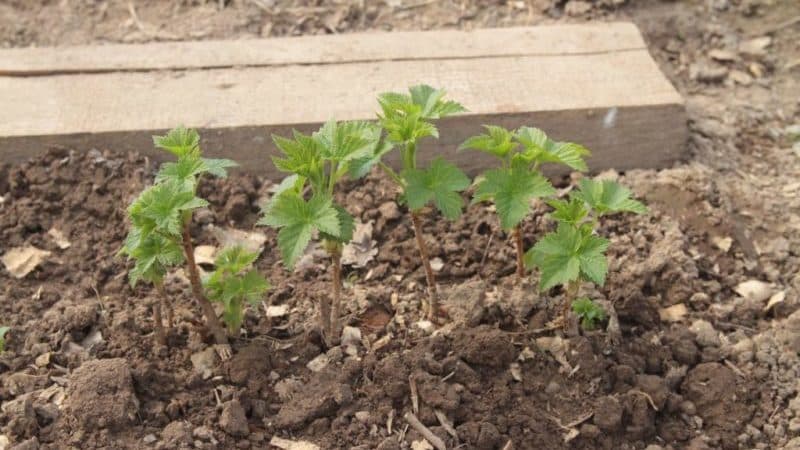
Berry bushes are capable of bearing fruit only with normal growth and development. The potential yield depends on the annual growth: the stronger it is, the higher the productivity.
The main task of the gardener is to create optimal conditions for the successful survival of currants in the first year of planting. It is important to maintain the growth and fruiting of the bush through proper soil cultivation, watering, regular fertilization, and systematic pruning.
Loosening of the soil is carried out once every 2-3 weeks, carefully breaking up the earthen crust and removing weeds. When watering, this ensures better penetration of moisture to the root system. Currant roots are located in the top loose layer of soil. To protect them from damage, the soil is loosened to a depth of 6-8 cm, in row spacing - 10-12 cm.
Mulching with organic matter helps retain moisture in the soil and prevents weed growth. In this case, the tree trunk circle can be loosened less often. Recently, gardeners have been using black film or agrofibre as a covering material. This technique eliminates the need for loosening during the summer. In autumn, the synthetic coating is removed to improve soil aeration, apply fertilizers and carry out other work.
In autumn, heavy loam is dug to a depth of 8 cm, leaving lumps to retain moisture. The sandy loam is loosened shallowly - 5-7 cm. In order not to damage the root system, the soil is dug up with a garden fork.
After autumn planting, fertilizers are not applied. The bushes have enough organic and mineral fertilizingintroduced during planting.The first portion of fertilizers is applied after 3 years in the autumn: 50 g of superphosphate, 15 g of potassium sulfate, 5 kg of compost for each bush.
The fertilizer application zone is determined by the location of the bulk of the roots. In currants, it is located under the crown of the bush and even a little further. Therefore, for adult plants, fertilizers are applied according to the projection of the bush crown.
From the age of 4, currants are fed annually with urea (20-25 g per bush). Organic, potassium-phosphorus fertilizers on loam are added once every 3 years in spring or autumn: 15-20 kg of organic matter, 120-150 g of superphosphate, 30-45 g of potassium sulfate per 1 m².
On light sandy loam and sandy soils and peat bogs, such fertilizers are applied every spring in a dosage for 3-year-old bushes. In summer, liquid organic-mineral fertilizers are applied and combined with watering. The mullein solution is diluted with water in a ratio of 1:4 and 10 liters are consumed per 1 m², bird droppings are diluted 1:10 and 5-10 liters are consumed per 1 m².
Instead of organic matter, it is allowed to use the Riga mixture (nitrogen, phosphorus, potassium) - 2 tbsp. l. for 10 liters of water. Consumption per bush - 10-20 liters. This fertilizing is recommended after harvesting to stimulate the formation of fruit buds.
In June, currants are additionally fed with foliar fertilizers: 1-2 g of copper sulfate, 2 g of boric acid, 2 g of manganese sulfate, 3 g of zinc sulfate, 2 g of ammonium molybdate per 10 liters. Each microelement is diluted in a separate container, then mixed in a large container. Fertilizer is applied into furrows 10 cm deep at a distance of 20-25 cm from the bushes. After watering, the depressions are leveled and mulched with straw, sawdust or peat.
Black and red currants love moisture and need abundant watering during dry periods.A lack of moisture leads to shedding of berries and freezing of plants in winter. Particular attention is paid to watering during the period of active growth and formation of ovaries, filling of berries and after harvesting. In autumn, water-charging irrigation is carried out to a depth of 50-60 cm. Water consumption per 1 m² is 30-50 l.
Features of propagation by cuttings of black and red currants
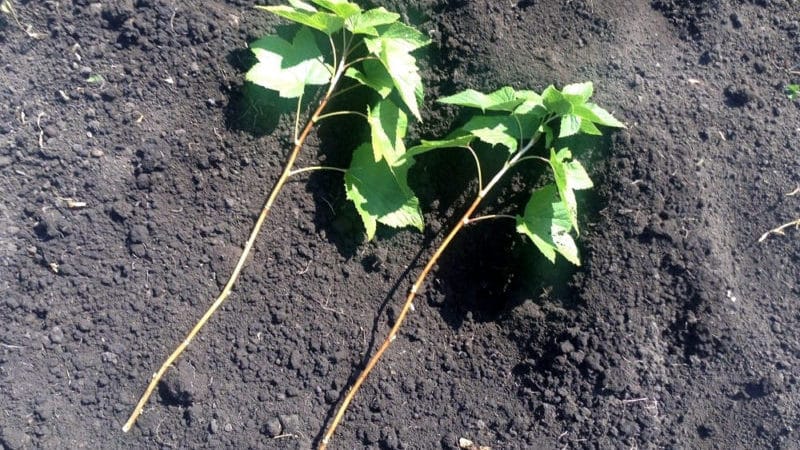
Red currants, like black currants, lend themselves well to vegetative propagation. The mother bush must have drought resistance, frost resistance, productivity, large size and excellent taste of berries, immunity to diseases and pests. The optimal age of a bush for cuttings is 10 years.
The procedure is performed in the morning or evening in cloudy weather. The lower sections are treated with growth stimulants and rooted in water or soil. Optimal soil humidity is 80%, air humidity is 90%.
Unlike the black variety, apical cuttings take root best in red currants. 4-6 buds are left on one cutting. The lower cut is made at an angle of 45°, 2 cm away from the lower bud. The upper cut should be even at a level of 1 cm from the upper bud.
For cutting red currant cuttings, choose annual shoots with light bark. Shoots coming from the roots are often used as planting material. Rules of care for red currant cuttings are the same as for black currant cuttings.
A year after planting in open ground, perform pruning, leaving 2-4 buds on the branch. All ovaries and flowers are pruned to stimulate the growth of side shoots.
Common mistakes to avoid
Among the most common mistakes made by novice gardeners are:
- Failure to follow the scheme for planting cuttings in open ground.Too dense planting has a negative impact on their development. The plant will experience a lack of sunlight. Dense plantings are an excellent breeding ground for fungi and insects.
- A lack of moisture and nutrition leads to drying out of the cuttings. Currants are a moisture-loving plant and require regular watering. Top dressing organic and mineral compositions stimulate the growth of green mass, the formation of berries and strengthen the immune system.
- Failure to comply with care rules. Currant seedlings need regular loosening of the soil, weeding, and disease prevention.
- Illiterate choice of mother bush. The better the quality of the source material, the better the survival rate of the offspring and the higher the yield.
Conclusion
Currant cuttings are considered the most labor-intensive and at the same time reliable method of propagating shrubs. Black currants take root best with green and lignified cuttings, red currants - with apical ones. The procedure is performed with garden pruners, the lower cut is made oblique, the upper cut is made straight. For rooting use water or soil. Cuttings prepared in the fall are planted in September - October, having previously prepared the soil and holes. Caring for currant bushes includes abundant watering, application of organic and mineral fertilizers, and mulching the soil.